SEO is an enormously popular buzzword for travel and tourism digital marketing. It’s easy to see why.
When integrated as part of a wider digital marketing strategy, SEO – or search engine optimization – has the potential to be the single most lucrative driver of revenue for travel companies.
It’s a key channel for some of the world’s biggest travel websites, like TripAdvisor, who dominate results in virtually all ‘best things to do in [location]’ keywords.
However, not all travel SEO is made equal, and different types of businesses will want to focus on the strategies that work best for them.
In this article, we’re going to explain the secrets behind successful travel SEO with 5 actionable strategies. We’ll also deep dive into a case study to see how a large travel site successfully implemented a holistic SEO strategy to bring in a huge amount of traffic.
Finally, we’ll touch on how different types of travel companies – whether that’s tour operators, hotels or luxury travel operators – can leverage search engines as part of their wider marketing strategy.
Read on to discover how you can use travel SEO to empower your business and turn your website into your most valuable asset.
The value of SEO in travel
I don’t need to tell you how important Google is for finding and booking travel.
It’s a well known fact that Google is the first and last stop for most people when they’re booking flights, hotels, and experiences.
When you optimize your site for search, you increase the chances that people who are interested in your destination will find your website on Google.
This is extremely important, because it provides a direct link to your website, and can help you reduce your reliance on online travel agents (OTAs).
Since OTAs usually charge a commission of between 10% and 25% of the sales price, you’ll benefit massively from driving direct bookings to your own site instead.
Driving direct traffic is hard, though, because OTAs dominate the search results.
OTA sites like TripAdvisor and Expedia have tens of thousands of listings, reviews, and information on hotels, accommodation and things to do in any given destination. Since Google values depth and quality of information, these sites tend to take the top positions on the search results pages.
It’s very difficult to outrank OTAs for certain keywords (e.g. ‘best tours in Naples’). This is where content comes in.
With written SEO content, you can reach travellers when they type in keywords adjacent to the destination, such as ‘authentic pizza in naples’. An in-depth article about the most authentic pizzerias in Naples, and why they’re authentic, will provide far more value than an automatically compiled list from an OTA on the ‘top 10 pizzas in naples’. And Google knows it.
By publishing a steady stream of in-depth content like this, you start to build up the authority of your website as a source of information on your destination. After that, you can outrank OTAs for specific terms and drive more visibility to your own website, rather than having to rely on someone else’s platform. What’s not to like?
Get direct bookings through SEO content
Outrank the OTAs and fill your calendar with direct bookings using Travel Content Pro, our end-to-end SEO content marketing service.
Pricing PlansSEO in the travel marketing funnel
There are multiple stages to the trip planning process. However, it very rarely takes a straight line.
The journey that a consumer takes between dreaming up a vacation and booking their trip involves multiple stages of research and overlapping search intentions.
In fact, most people searching for travel information online aren’t even ready to book a trip, at least not yet.
So, more so than in other industries, travel SEO is about understanding touchstones and the customer journey.
The following image shows how SEO interacts with the travel marketing funnel:
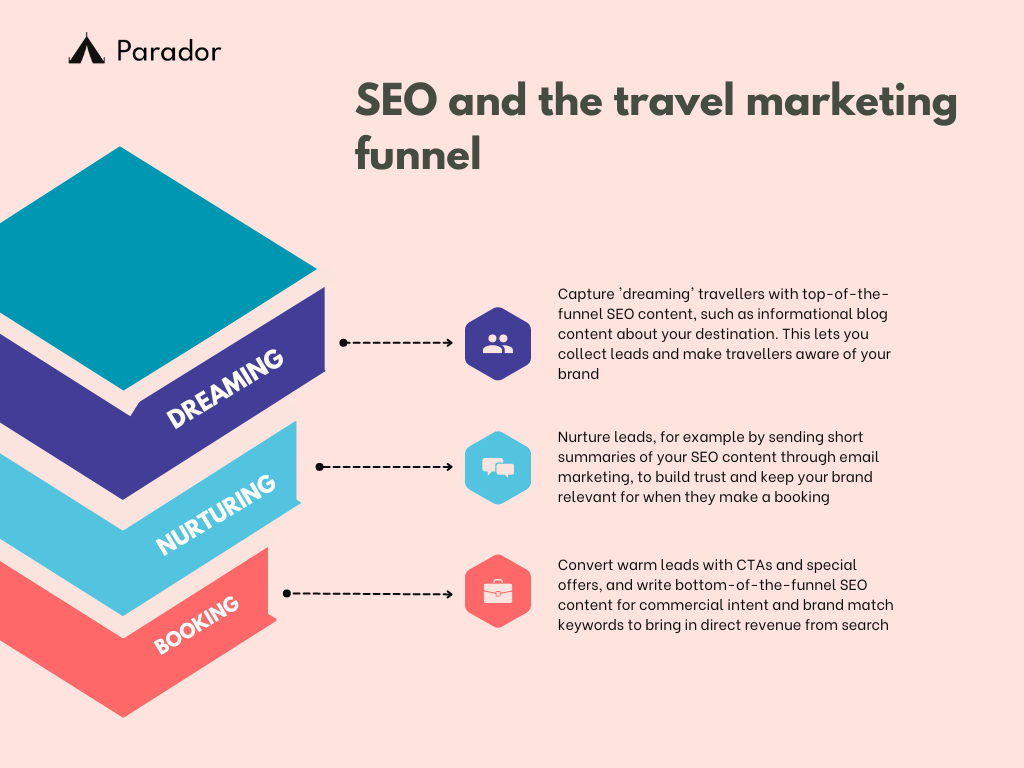
There are different types of keywords at each stage of the funnel, each with a different search intent.
To complicate things further, each type of keyword will require a different approach; some are more suited to blog content, while other keywords should be targeted with dedicated landing pages.
If we break all this down, it soon becomes clear that typical SEO strategies that might work in other industries, such as ‘find a profitable keyword and optimize for it’, aren’t necessarily as effective in the travel industry.
Hence, the rules of success in travel SEO are:
- Understand your customer
- Understand the journey they take when researching a trip
- Define which parts of that journey are most important to your business (your touchstones), and
- Make yourself visible at those touchstones with a carefully planned SEO strategy.
Once you have this foundation in place, you can start to build a high-performing marketing funnel with SEO as its engine.
5 essential SEO strategies for travel companies in 2023
As we’ve seen, the travel industry faces unique challenges in search optimization.
‘Window shopping’ is extremely common in travel (this is when people look for information about a destination without having the intention to book a vacation).
Travel is also plagued with an extremely long sales cycle, as well as fierce competition from OTAs and major travel brands.
The best way to tackle the unique challenges that face the travel search landscape is by making your website visible for multiple types of queries, and not necessarily just the highly competitive keywords.
This will allow potential customers to find your site over and over again, at each stage of their travel planning.
Let’s look at some examples of what these queries might be.
Strategy 1: Untangle your keyword research
Keywords are the basic script used by travelers to find your site on search engines like Google. Without keywords, there is no SEO strategy.
However, the travel industry is notorious for having a huge amount of keywords. So, a good starting point would be to untangle these different types of keywords and learn how to identify them.
Read more: our guide to carrying out effective keyword research for tour operators
We can group the different types of travel keywords by their search intent (search intent in SEO refers to the intention a searcher has when they type a query into Google, and Google is becoming increasingly more sophisticated at understanding search intents and matching them to queries).
Informational keywords
Informational keywords are queries that people type in when they’re looking for general information about a destination.
They usually aren’t ready to book, but the information they find will tend to move them closer towards a decision.
For example, a keyword like ‘best time to visit palma’ is a firmly informational keyword. The search intent is clearly for information about when to visit La Palma, rather than for a way to book a flight, for example.
The top ranking page for the keyword we mentioned above is taken by British airline TUI, with an informative landing page that gives advice on the best time to visit La Palma.
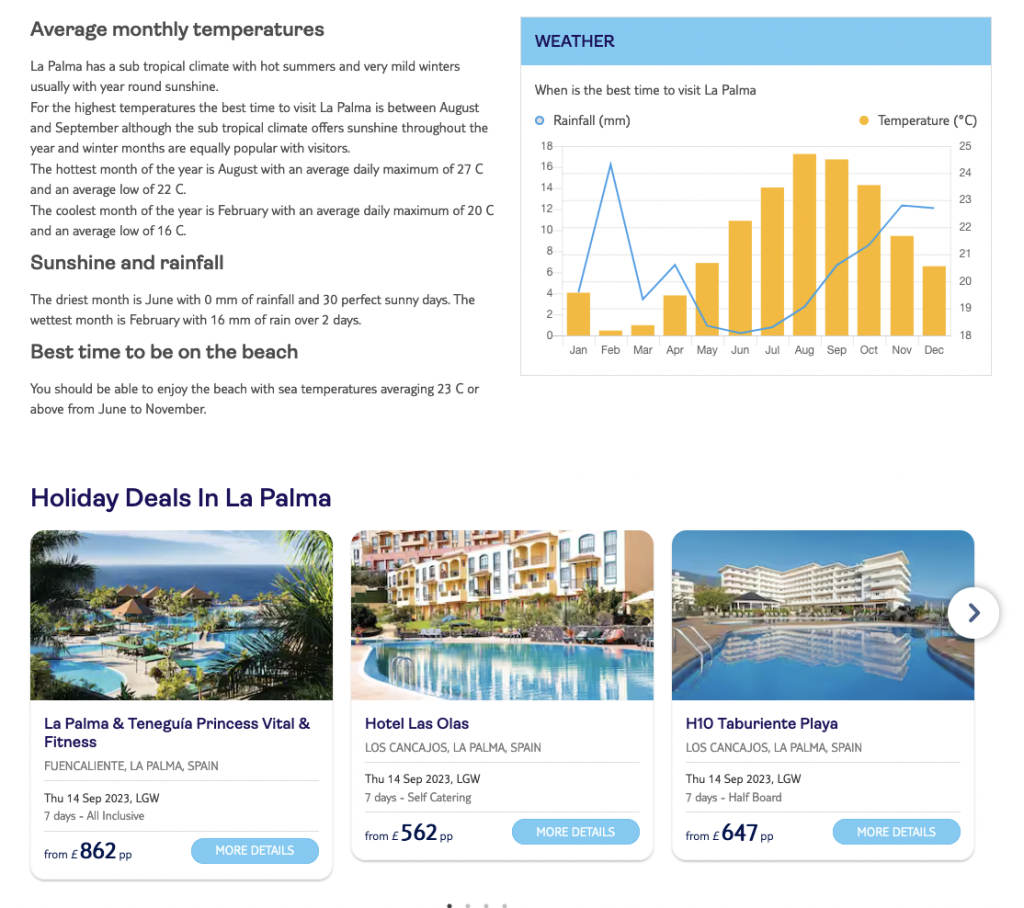
Directly underneath this information, however, TUI have placed high-quality photographs of different partner hotels in La Palma. The idea here is to entice searchers who have expressed an interest in a destination into thinking about where they might stay, which leads them directly to the next stage of the travel sales cycle.
Further reading: Creative Angles for Tourism Promotion
And, having already been made aware of a series of beautiful hotels on the TUI website, there’s a high chance that TUI will be the first brand that comes to mind when the customer does start to think seriously about booking a holiday.
This is a great example of a large travel brand leveraging the power of informational keywords to get one step ahead of their competitors and keep their brand front and center throughout the travel search experience.
As you can see, while ranking for informational keywords isn’t as directly valuable as ranking for commercial keywords, they can still be very lucrative as entry points to your travel marketing funnel.
Transactional keywords
Transactional keywords are – you guessed it – keywords that have a commercial search intent.
There are a few tell-tale signs to identify a keyword with this type of intent.
One extremely popular keyword type that we see across many destinations is ‘best hotels in [destination]’. This keyword implies that the searcher wants to book a hotel (transactional), but they want to see a comparison of the best hotels in a location before they’re ready to make a decision.
For this reason, transactional intent keywords are highly competitive, and small travel brands often have to compete against huge websites like TripAdvisor and Booking.com.
That doesn’t mean that transactional keywords shouldn’t be targeted, but it does mean that you have to be more selective about which transactional intent keywords you choose.
For example, consider the following two keywords:


Let’s imagine that you’re a travel agency trying to get more bookings for a partner hotel. While it would be tempting to target the keyword with 34,600 monthly searches, the level of competition here is fierce: TripAdvisor, The Times and Condé Nast Traveller are all competing on the front page.
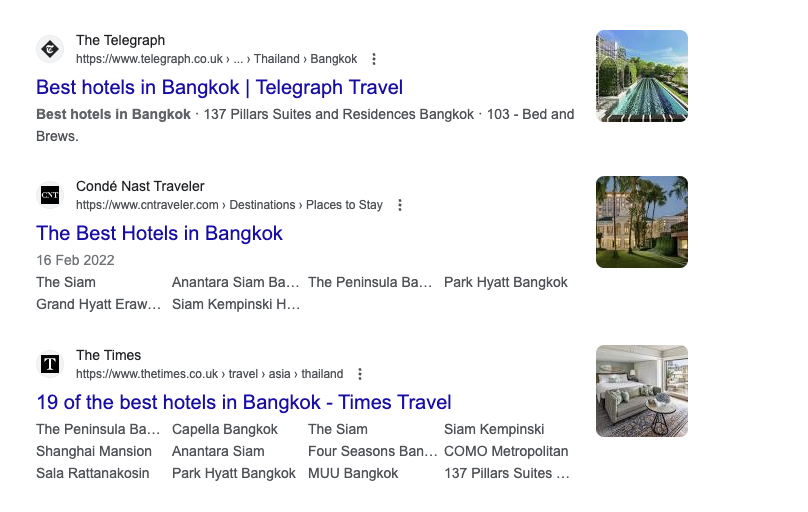
Since these are huge sites with thousands of backlinks, the chances of facing up against them are slim, even with insightful, expertly crafted content.
However, the second keyword, ‘where to stay in bangkok with family’, has a much lower keyword difficulty by comparison (12 vs 39). And while there are far less searches per month, this keyword is going to be a whole lot easier to rank for.
Ask yourself the following question: would you rather rank on the third page for a keyword with 34,600 searches, or at the top position for a keyword with 490 searches?
Knowing that 75% of searchers never scroll beyond the first page, I know which one I’d pick.
This strategy is known as targeting long-tail keywords, which are keywords that carry a very specific intention (such as ‘where to stay in bangkok with family’).
The winning formula for smaller travel companies is to find and target specific long-tail keywords that also have commercial intent, which will allow you to beat the OTAs and drive more qualified traffic to your website from searchers who are ready to book.
Brand match keywords
The third type of travel keyword to be aware of is branded keywords.
Branded keywords are keywords that mention a specific brand or company, such as ‘hyatt regency chicago’ or ‘british airways’.
These types of keywords tend to have a mixed search intent, because it’s not always clear from the keyword alone whether the searcher is looking for information or whether they want to make a booking.
Either way, it’s important to optimize for them, not least because OTAs have a tendency to place sponsored ads for branded keywords of popular hotels, resorts and tours, which appear above the organic search results.
You can optimize for branded keywords by using your brand name in title tags and meta descriptions on your most important pages, and by building citations across the web for your business.
Bigger travel brands might have a range of different long-tail branded keywords attached to their brand. In this case, you should carry out keyword research to find out what these keywords are, and optimize for them with dedicated pages (we’ll explore this later in the section for hotels and resorts!).
How to map search intent
We’ve identified three types of keywords, but it’s important to remember that not all keywords fit neatly into one of these categories.
Just like brand match keywords don’t always have a clear search intent, there are some keywords that can be either informational or transactional depending on which stage the searcher is at in the travel booking process.
For example, a search for what to do in a destination (with a keyword like ‘what to do in hong kong) might mean that someone is looking for information to help them decide on whether to book a vacation, which makes it an informational search.
On the other hand, they might have already booked their flights and now want to book tours and activities, which gives the keyword a commercial intent.
This is just another illustration of the complexity of travel SEO, and it reinforces the importance of addressing all stages of the funnel when it comes to choosing your keywords.
The best way to help you decide what to prioritize is by mapping keywords to their search intent.
This will give you a high-level overview of which content to tackle, while helping you to position that content to fully match the intent of the searcher.
In the example below, I’ve mapped a list of keywords related to our hotel in Bangkok to their search intents:

After carrying out this exercise, I can see that I have around five commercial keywords, which should be prioritized as the first keywords to tackle in my strategy.
Once I’ve created content for the commercial keywords, I’ll start tackling the informational keywords. These are less likely to drive bookings, but they can be entry points for my marketing funnel which I can use to capture email addresses and increase the visibility of my brand.
Finally, by bundling commercial and informational keywords together, I can create a topical cluster about my destination.
This involves grouping related keywords together to create semantically linked content across a website, rather than on a single page. It’s a powerful ranking factor for Google.
For example, by creating content around informational keywords related to my area (such as ‘sukhumvit area bangkok’ and ‘sukhumvit night market’), I show that my website is an authority on the Sukhumvit area. I could also write about transport options, restaurants and attractions.
By doing this, the page I wrote targeting ‘where to stay in bangkok with family’ becomes more authoritative, because I have a wealth of other content on my site which shows that I’m an authority on Bangkok and the Sukhumvit area.
Once these pages are linked together, Google almost always rewards topical clusters with higher rankings.
To sum up this section, intelligent keyword research sets the foundation for a good SEO strategy, which in turn can be the basis of an excellent marketing strategy.
Search volume and keyword difficulty are important metrics, but search intent is also extremely important in travel, as well as the topical clusters that you choose. By linking all these together, you can understand and untangle the different keywords that are best for your site, and bring them into your wider marketing funnel.
Strategy 2: Execute a local SEO campaign
Local SEO is the practice of optimizing your website to appear in local listings and directories.
Google returns listings and directories – such as Google Maps – for transactional searches that have a navigational aspect, such as ‘near me’ searches or ‘[service] [location]’. An example of this would be ‘bike hire amsterdam’.
These keywords are potential goldmines, because the searcher is looking for a business to carry out a transaction. This is why Google shows the map pack of local businesses for these types of searches.
Local SEO is especially important for hotels, apartments and tour guides, because it represents an opportunity to outmaneuver OTAs and online brokers. Since OTAs are not local businesses, they cannot rank in the map pack.
And with 46% of all searches having local intent, travel brands need to make sure they have a solid local SEO strategy in place to capitalize on the potential revenue available.
Show your business to interested travelers
Our Local Visibility package drives exponentially more bookings from local search to your business, month-on-month, year-on-year.
Find out howHow to find local keywords
A local SEO strategy begins with finding the local keywords that people search for.
To do this, you can use Google Keyword Planner, a paid tool like Ahrefs or SEMrush, or even just the Google search page itself!
Let’s find some local keywords without leaving Google. A quick look at the Google Autofill suggestions for ‘bike hire amsterdam’ gives us a range of local keywords right away:
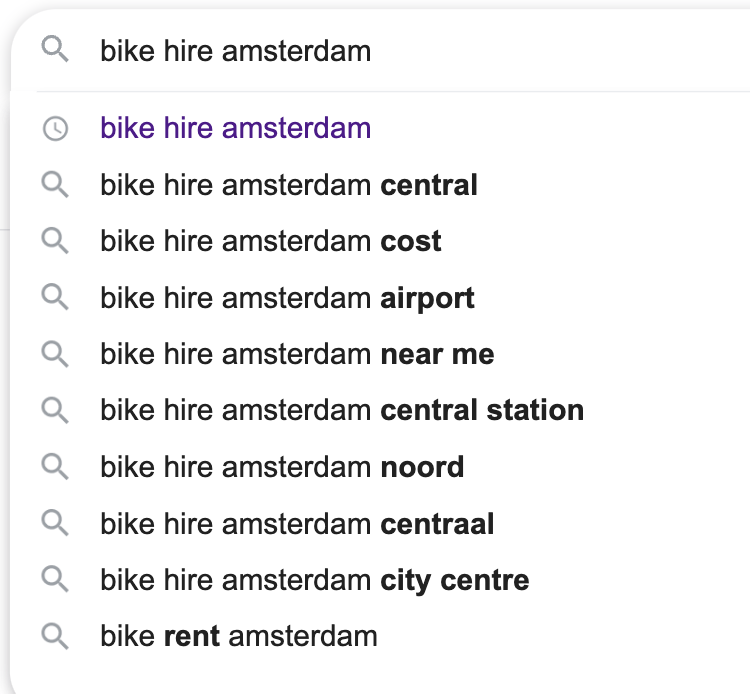
In this example, I’m going to make a note of the suggested keywords, map out their search intents, and set up discrete landing pages for each of the important keywords.
For example, the search intent of the keyword ‘bike hire amsterdam cost’ is for information on the cost of bicycle hire in Amsterdam.
With that in mind, I’m going to create a dedicated page that explains the price of bike hire in Amsterdam while directing searchers towards my service.
For the keyword ‘bike hire amsterdam central’, I would create a page that explains the location of my bike hire station in the center of Amsterdam.
And so on.
If you operate in multiple locations, you could consider creating separate pages that target the local keywords relevant to each location.
Your landing pages should utilize SEO best practices like including the keyword in headings and metadata. It needs to be genuinely helpful to the searcher, and not just a plug for your own services.
You should also include your local keywords in alt tags for images that you use to depict your service. For example, an image for your ‘bike hire amsterdam central’ page could have the alt tag ‘picture of bike for hire in amsterdam central’.
Finally, consider asking your own customers what keywords they would type into Google when looking for your service, and building local pages around those terms, too. Not all local keywords will be visible from within Google or keyword research tools, especially the lower volume ones.
How to get in the Google map pack
The other part of local SEO is the map pack, which is the ‘Places’ section that appears for navigational keywords like ‘bike hire amsterdam’.
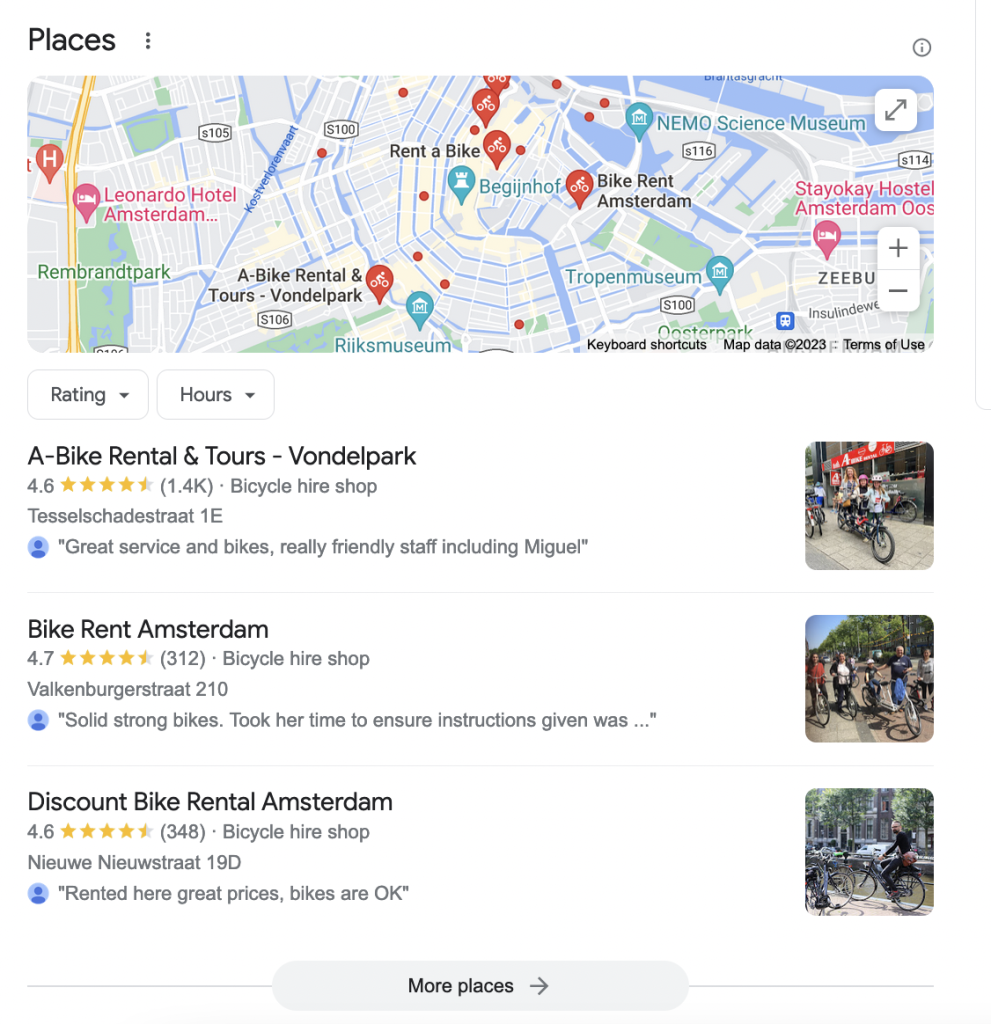
The key to appearing in the map pack is having a well-optimized Google Business Profile.
When somebody types a local query into Google search, Google wants to show the businesses that are most relevant to that query.
That means you should optimize your Google Business Profile to make your business more relevant to the local keywords that people search.
In this example above, businesses have used variations of the keyword as their business name (Bike Rent Amsterdam, Discount Bike Rental Amsterdam). You can also include them in your business description, services, or FAQs.
Remember that your use of keywords needs to be natural, since keyword stuffing is a negative ranking factor. That just means you should avoid shoving keywords in your description for the sake of it; rather, you should weave them naturally into your listing in a human-friendly way.
If you don’t have a Google Business Profile, you can set one up by following the instructions in this video.
Pro tip: stand out from the competition by placing an emoji in your Google Business Profile name. This is a simple way to draw attention to your listing on a crowded map pack!
To give yourself the best chance of ranking in the map pack, try to complete all of the fields available inside your Google Business Profile. The more information you include, the more reason Google has to show your business for searches relevant to the services you offer.
This includes high-quality photos, website links, opening hours and descriptions of services. Make sure to keep them all updated, and to nurture positive reviews from customers.
Finally, it pays off to be consistent in creating Google Business Profile posts, and to provide updates on your services or special offers for customers. Being active in the use of your business profile is another positive signal for Google!
NAP consistency
No, NAP consistency isn’t to do with catching a few winks in the afternoon.
It refers to having your Name, Address and Phone number appear consistently in different places around the internet.
NAP is a ranking factor for local SEO, because it helps Google to verify the legitimacy of your business. NAP inconsistency, on the other hand, confuses users and prevents the Google crawlers that scan the Internet from building up a consistent picture of your business.
You can use a paid service like BrightLocal’s citation builder to set your business up on a range of different business directories. Alternatively, you can carry out this task yourself.
Consider the top directories relevant to your business, such as Tripadvisor, Expedia and Apple Maps, for example, and aim to be listed on as many as possible (social media profiles also count!).
Remember, though, that any changes to your name, address or phone number will have to be reflected across all of the directories and citations you’ve built, so do keep a track of where your business is listed so that you can edit citations if you need to.
Finally, OTAs are also directories, so having your business listed on as many as possible will help Google to verify the legitimacy of your business.
Local SEO can be a seriously powerful investment for businesses that engage customers via a physical location to bring in customers.
By investing the time to optimize your Google Business Profile, building citations and creating local landing pages for your top local keywords, you should start to see an increase in customers that find you through local keywords, which are huge revenue-drivers for physical location businesses.
Strategy 3. Acquire high-quality travel backlinks
Backlinks are links to your website from around the internet. Google sees them as ‘votes of confidence’, and the higher the domain authority (DA) of the site that links to you, the more powerful the backlink is.
Backlinks increase the authority of your site, which generally influences your rankings for keywords.
Backlink relevance also plays a part. This means that building links from other travel sites that have some kind of relation or similarity to your service will have more effect than building links from sites not related to yours.
As you can see, backlinks are an important part of the Google algorithm. Here’s how travel brands can build them in 2023:
Building links with linkable assets
I’ll be honest, link building is one of the more difficult aspects of SEO.
However, savvy travel sites can build up a strong backlink profile by creating useful resources which other sites will want to link back to. Let’s call these resources ‘linkable assets’.
Here are some common linkable assets used by travel brands:
Writing definitive guides
If you’re among the first to publish the definitive guide around a certain travel topic, you have a higher chance of getting backlinks from others who are researching that topic.
New sites can use this method to gain backlinks by publishing high-quality guides around low-competition keywords. If the keyword competition is low enough, high-quality guides will rank quickly (even if the site in question doesn’t have many backlinks yet).
You can use Google Trends to gauge the popularity of travel topics and catch onto new trends for content ideas. Keyword research tools are also helpful in understanding which topics to target.
Since you’re aiming for keywords without too much competition, the first few guides you write will likely be niche guides around long-tail keywords that others haven’t tackled yet. That’s fine, though, because writing them will help you build up authority to tackle the bigger keywords later on.
Hosting a travel podcast
Podcasts and radio shows are highly linkable assets, which make them great for increasing your backlinks and site authority.
You could host a weekly podcast about your destination, detailing the best travel tips and things to do in your destination. You can also build traction for your podcast by inviting other experts to guest on your show.
And since podcasts naturally pick up backlinks, this is a great way to send authority to your site from around the web.
For example, American travel expert Rick Steves hosts a weekly radio show called ‘Travel With Rick Steves’. The resource page for this podcast on the Rick Steves website registers 23,000 backlinks alone:

All these backlinks have a significant effect on the authority of the site, which then influences rankings for the tours that Rick Steves also sells through his website.
By carrying out podcast keyword research you’ll be able to see which topics people are interested in. From there, you can start building your podcast and promoting it through email marketing, social media and podcast directories.
Building lists and resources
High-quality resources about your destination, such as lists of hotels or local events calendars, can be amazing link magnets for your website.
Finally, consider carrying out surveys with your customers or in social media communities to gather your own data. This data can be repurposed as case studies and infographics, which are valuable for others doing research on your destination or the travel industry at large.
Infographics in particular can be promoted on social media platforms like Pinterest and Instagram to help you reach a wider audience and pick up natural backlinks.
Strategies for building travel backlinks
Now that we’ve covered linkable assets that will naturally build backlinks, let’s look at some things you can do to speed up the process.
If you don’t have time to wait for a linkable asset to build up momentum, you can employ link building strategies which will proactively gain backlinks for your site.
Link building involves going out and finding links, rather than waiting for them to come to you.
HARO for travel
One way of doing this is by using the travel section on HARO (Help A Reporter Out) to find journalists who need expert insight for their travel articles.
Link building on HARO works like this: a journalist submits a request for insights and opinions on an article they’re writing, which you can provide. If you answer the request within the allotted time frame, you have a chance of your expert input being included in the article that they eventually write. This mention will normally have a backlink to your site or profile attached to it.
Since news sites tend to have a high DA, HARO can be a great source of high-quality backlinks, but it requires perseverance and consistency to keep up with journalist requests (who are often inundated with responses themselves).
Broken link building
One of the most popular link building strategies is the broken link building method. It basically involves finding broken links on other travel sites to content similar to yours, and asking the site administrator if they’d like to swap out the old broken link for one to your site.
The broken link-building method looks like this:
- Find high-ranking pages for services or blog content similar to yours
- Use an SEO tool like Ahrefs or Semrush to see what backlinks the site has
- Use a site audit tool to scan the page for broken links
- Contact the site administrator to point out the broken link, and offer your website as a replacement
Since broken links are bad for SEO, many website owners will be happy to swap out a broken link for yours. Finding and identifying the broken links takes time, however, so be prepared to put in some serious hours with this method.
Strategy 4: Carry our regular technical audits
For any serious travel SEO effort to work, your website needs to be easily legible for Google.
That means that the Google crawler should be able to properly crawl and understand your site, and understand the relationship between your pages.
Tasks related to website architecture and improving the ability with which Google can render and index your site fall under the branch of technical SEO.
Having a well-organized website indirectly boosts your ranking, which is extra important for larger travel sites with many pages for different tours and destinations.
For this reason, it’s a great idea to carry out regular technical audits. They help you uncover problems on your site that may be affecting indexing or user experience.
For example, you might think you have a great PageSpeed score (a ranking factor for Google), but a background plugin update may bring this score down without you realizing. A routine technical audit would surface this problem so that you can take steps to fix it.
You can use the indexing and page experience reports in Google Search Console to check for technical errors, such as non-indexed pages, mobile errors and URLs with bad page experience scores.
However, to be sure your site is operating at its full potential, consider carrying out a full travel website SEO audit with Parador. We’ll provide a full report into over 30 different ranking factors for your travel website, and make qualified suggestions to give you the edge over competitors.
The below example shows the indexing report for a website that has several pages that aren’t appearing on Google, ordered by their reason for not being indexed. This report is extremely helpful, because it lets you identify common problems that might be affecting many pages on your site:
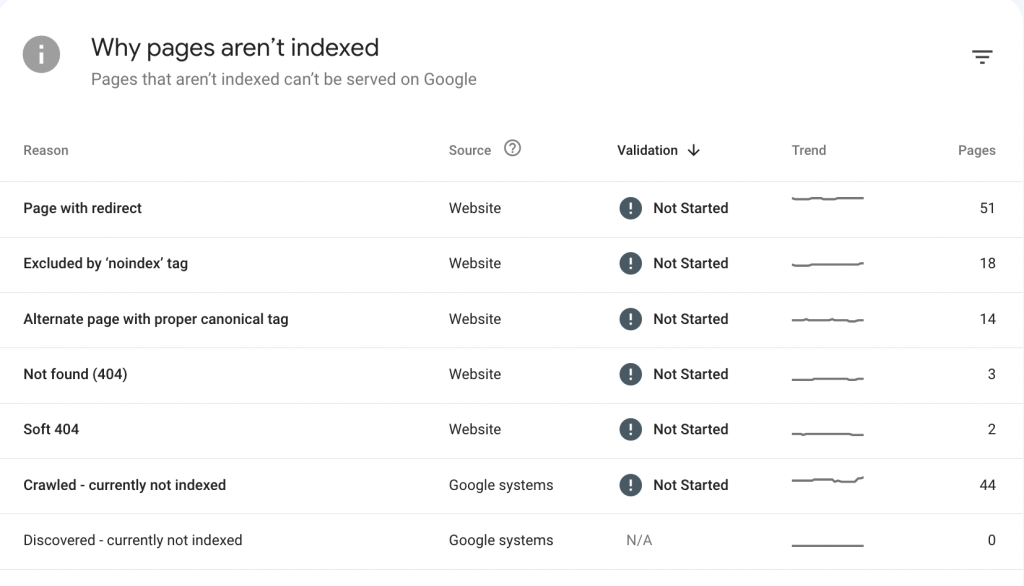
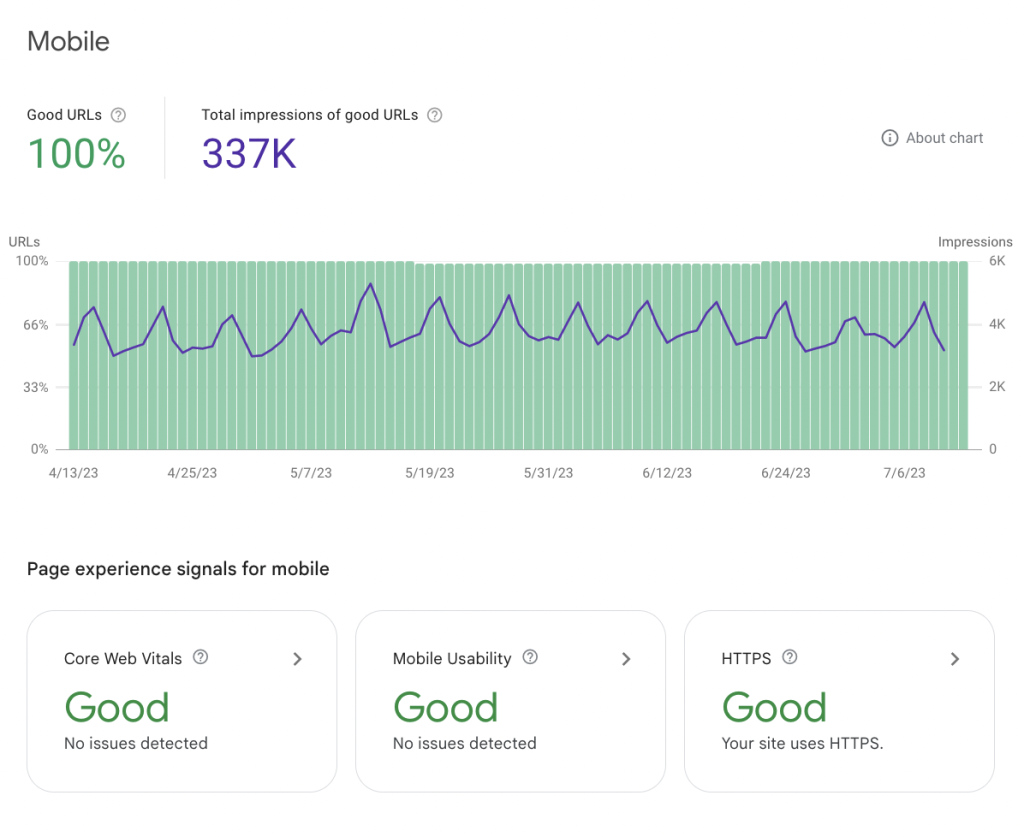
While you don’t have to check the Google Search Console reports every day, it is a good idea to keep an eye out for potential problems. How often you perform technical checks depends on the complexity of your site structure, and how many pages you have. For most of our travel clients, a thorough monthly check is sufficient.
If you want even more insights into potential technical problems, paid crawling tools like Screaming Frog’s SEO spider can give you even more detailed reports on how your site is performing from a technical point of view.
Best practices for technical SEO in travel
There are certain best practices for technical SEO that are universal, like having a fast, mobile-responsive website.
However, there are some technical SEO mistakes that we see travel sites doing again and again. Here are some of our technical best practices for travel (trust us, putting these into action will save you time later down the line):
1. Be careful with tabs
Tabs are a popular option for tour pages in particular, because tabbed content allows you to condense a lot of information onto one page.
However, tabbed content has been known to obscure information from both site visitors and search engine crawlers.
Although Google can read any content in the HTML, you need to be sure that content hidden inside tabs is actually accessible to the user. Tabbed content that looks hidden or inaccessible (even if that isn’t the intention!) might be seen as shady, so try to only use tabs on tour pages in a way that genuinely improves the user experience.
2. Keep tour pages to a minimum
Let’s say you offer a particular trip that has several possible itineraries.
Your flagship offer might be a three-day excursion to a particular South African wine region, for example, with three possible routes or modes of transport.
Rather than having separate tour pages for each route, it would be better to keep all the information for all three tours on one page.
Instead of assigning the same keyword to three pages, which can be confusing, you instead publish one single page that contains all the necessary information about that tour. Within that page, you could add discrete sections for each tour, supported by in-page linking to support the user experience.
This helps to condense the information architecture of your site, making it easy for Google to understand which pages are important, and rank them accordingly.
3. Maintain solid site architecture
The units of travel are continents, countries, regions, and destinations. For this reason, travel websites often feature individual pages for each of these units.
This approach has its benefits, but it also amounts to a lot of different pages. And many of those pages might have similar, if not identical, content.
Hence, it’s important to plan your travel website architecture meticulously and be consistent in how you organize information.
For example, a common top-level navigation that we see for travel sites is:
Home / Region / Country
In practice, that might look like the following:
Home > Latin America > Uruguay
This is a logical structure, because it allows country pages to be grouped under region pages. It will also allow you to have further pages for attractions within each country, if you wanted to.
And with breadcrumbs at the top of each page, it will allow your users to easily see where they are within your website structure.
Technical SEO isn’t the most important ranking factor for travel SEO, but you do need to keep an eye on it, because things can quickly get out of control.
Strategy 5: Measure and report your results
Once you’ve put the tips in this post into practice, you’ll need a system to measure the effectiveness of your travel SEO campaigns.
There are a number of metrics you can use to measure your result. These could be keyword positions for your main keywords, traffic, or impressions.
Keyword position is often a vanity metric, however. While it can be helpful in understanding how well a piece of content is optimized for a particular keyword, it doesn’t tell us anything about how much traffic a particular page is driving to your site from Google.
Organic traffic is the best indicator of how well your SEO campaign is going. The total organic traffic sent to a page is the sum total of how well a page is optimized for not just its main keyword, but long-tail and related keywords. It’s also helpful in understanding how much a particular page is contributing to your overall site traffic.
You can measure each of these metrics – for free – using Google Search Console. Here’s how to set up Google Search Console and submit a sitemap (this is a document which tells search engines which of your site’s pages it should crawl and index) .
How to set up Google Search Console
First, make sure that you have a Google account that you want to use for your business. Once logged in to your account, go to the Google Search Console landing page and click ‘Start Now’.
When you’re inside Google Search Console, you can add a property using the drop-down menu on the top left.
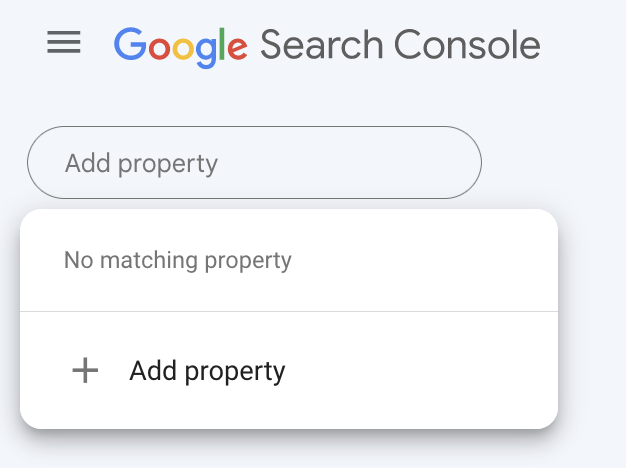
Next, enter the domain you want to use. If the Google account you’re using is connected to your domain (eg your company email address), then Google can automatically verify that you own the domain.
If your Google account isn’t connected to your domain, you’ll have to verify your site ownership using one of several verification methods, such as uploading a HTML file or inserting a tracking code on your site. Use this guide from Google to find out about the different verification methods available, but don’t worry – it’s fairly simple to get verified.
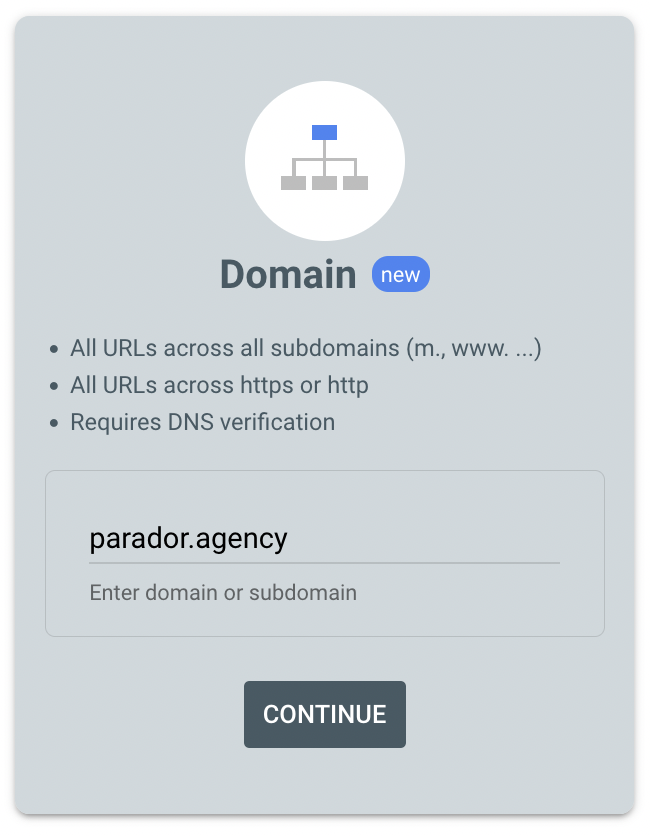
Once your property has been verified in Google Search Console, you can add your sitemap under ‘Sitemaps’ in the left-hand menu. This is the directory of all the pages in your website, and it tells search engines which pages to index (and which pages not to index). Sitemaps help Google to understand your site better, and allows crawlers to see when pages were updated.
The exact process will vary depending on your website setup, but sitemaps are usually located at yoursite.domain/sitemap.xml. If you can’t find it, you may need to create one with the help of a plugin or free sitemap tool.
Now that you have your sitemap URL, go ahead and submit te in Google Search Console under the ‘Sitemaps’ section.
Google Search Console will start to gather data about your site visitors over time, which you can view using the filters in the ‘Performance’ section. This view will help you to understand how certain pages perform for your target keywords over time, with data on rankings, clicks and impressions.

These keyword and page reports will give you valuable insight into how your travel SEO strategy is working, and what you need to work on.
For example, you’ll be able to use it to analyze fluctuations in traffic over time, such as when a page starts to gain traffic after optimization (or vice versa), or how technical website changes affect site-wide traffic.
You can go a step further and export the data from Google Search Console into your own Google Sheets or Excel spreadsheets to get even more insights and track search results against your own KPIs.
Thus, measuring and reporting in Google Search Console is vital to help you take a broader look at your travel SEO strategy, see which areas are working, and understand which areas need improvement.
The TripAdvisor Example
TripAdvisor was founded in 2000, and is now one of the world’s biggest directories of travel information. Through the TripAdvisor website, travelers can discover information about different destinations, such as attractions, hotels, accommodation and things to do.
The main driver of TripAdvisor’s growth? SEO.
Organic search is by far TripAdvisor’s biggest traffic channel, accounting for a massive 70.29% of website visits.
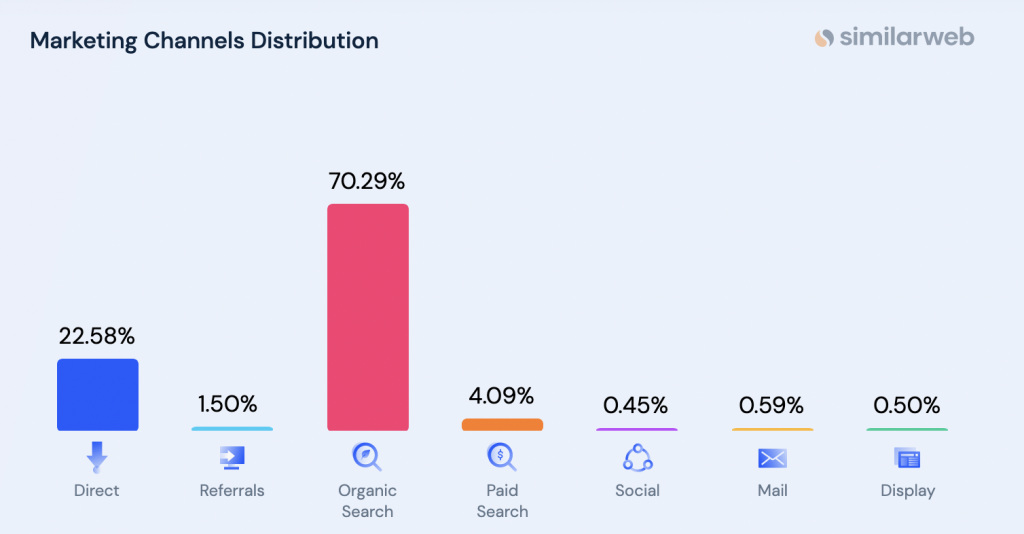
While some of this traffic arrives on TripAdvisor through brand-match keywords, such as people searching for ‘tripadvisor’ directly within Google, the vast majority of clicks to their site come from experiential keywords, such as ‘restaurants near me’ or ‘things to do in [location]’.
The reason that TripAdvisor can rank for so many keywords is simple: the volume and depth of information that they offer about different destinations far surpasses any competitor.
Since TripAdvisor maintains listings for attractions, restaurants, tours and accommodation, they are able to provide a one-stop shop for basically all the information someone might need on a certain place.
Not only can users see opening hours, location and photos of different locations, but, thanks to the size of the platform, TripAdvisor is able to show nearby amenities and related businesses that are also listed on the TripAdvisor platform.
The other key component of the TripAdvisor strategy is user-generated reviews. Vetted reviews are a heavily weighted signal of authority to Google, because they tend to contain unbiased information from people who have actually used the service. With the increase in AI-generated content, user generated content is likely to keep playing a big role in verifying the legitimacy of a website.
All of this information is then aggregated into SEO-friendly landing pages through intelligent deployment of discrete information hubs that target destination keywords, such as ‘things to do in [location]’.
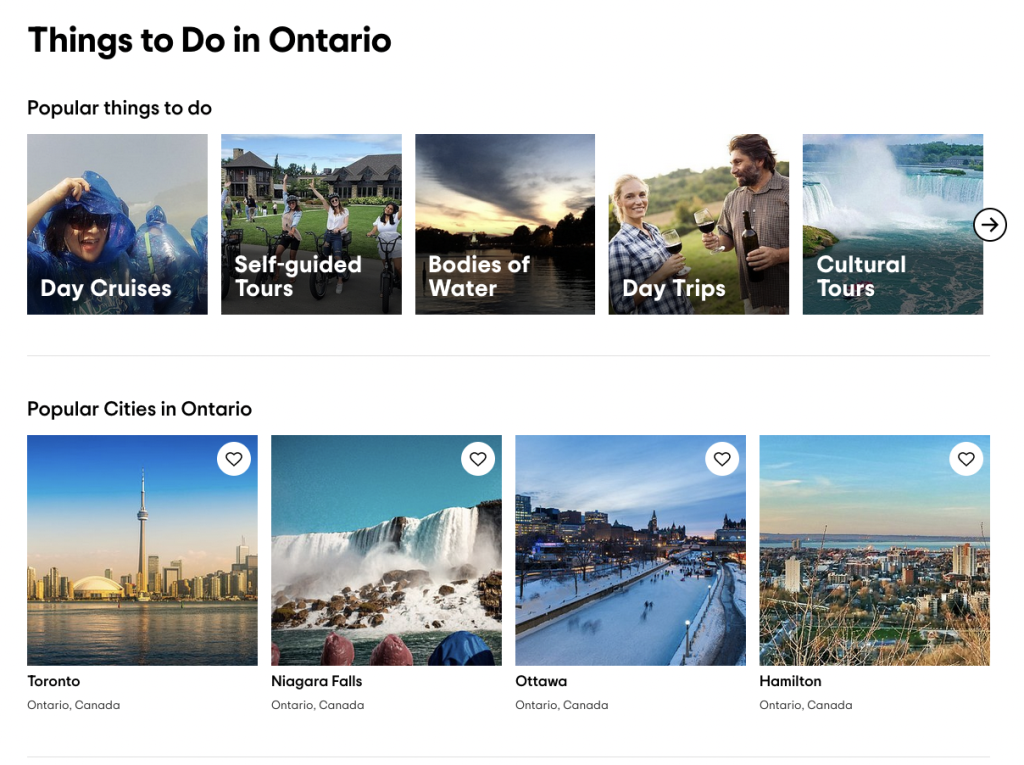
These landing pages display each category of activity within a destination, as well as destinations within destinations (such as cities within states or countries). Through easily accessible subpages, users can find all of the information they need to help them plan a trip, from nearby restaurants to user-submitted reviews, simply by browsing through TripAdvisor.
TripAdvisor’s search strategy is an example of two of the most important principles of SEO in 2023, which are:
- Providing valuable, high-quality information
- Providing it in an easily accessible, user-friendly format
We can see that TripAdvisor’s heavy emphasis on SEO has allowed them to eliminate virtually any dependency on pay-per-click search marketing, which only makes up 5.5% of their total traffic from search engines.

Smaller travel companies can’t be expected to compete with TripAdvisor in the results pages straight away. TripAdvisor has gained a competitive advantage due to the sheer depth of information available for different destinations, which would take years to replicate.
However, studying the TripAdvisor model provides some key insights for smaller travel companies to implement in their SEO strategy:
- Expertise is king: as TripAdvisor contains hundreds of thousands of listings for destinations and attractions, they are effectively one of the world’s best resources for travel. This is a signal of expertise and authority for Google, which rewards it in the rankings.
- Maintain a human-friendly site structure: each destination information hub on TripAdvisor is neatly categorized into human-friendly lists that compel searchers to click, scroll and interact with the website to find the information they are looking for. These interactions sends positive signals to Google, such as bounce rate and time on page.
- Create landing pages for your destinations: if you offer excursions in Thailand, Vietnam and Cambodia, build landing pages that target each of these destinations and the keywords around it. Depending on the scope of your services, you might even want to build out landing pages for each city or specific area within those destinations, which will allow you to target more keywords and gain clicks from travelers looking for your specific destination.
- Reviews, reviews, reviews: user-generated content is a trusted source of legitimacy for Google, and it likes to return TripAdvisor results that feature lots of reviews when somebody is searching for information. Travel companies should encourage customers to leave reviews on their Google Business Profiles, which will help with local SEO and keeping bookings in-house.
SEO for different types of travel companies
While there are general SEO tips and strategies that can be beneficial to all websites, there is no one-size-fits-all strategy. Different types of travel websites will need to tailor their approach according to their marketing aims, objectives and target markets.
Next, we’re going to provide an overview of the different SEO strategies that are applicable to different types of travel companies, such as tour operators and hotels. You’ll also find dedicated guides for each of these, should you wish to find out more about SEO particular to your travel company.
Tour operators and travel agents
Tour operators and travel agents have some unique attributes that mean they can benefit from using local SEO, combined with a solid content strategy, to drive qualified leads to their site.
Read more: how to do SEO for tour operators in 2023
Since OTAs aren’t local businesses (they’re online), they can’t appear in the Google Map Pack for local search results.
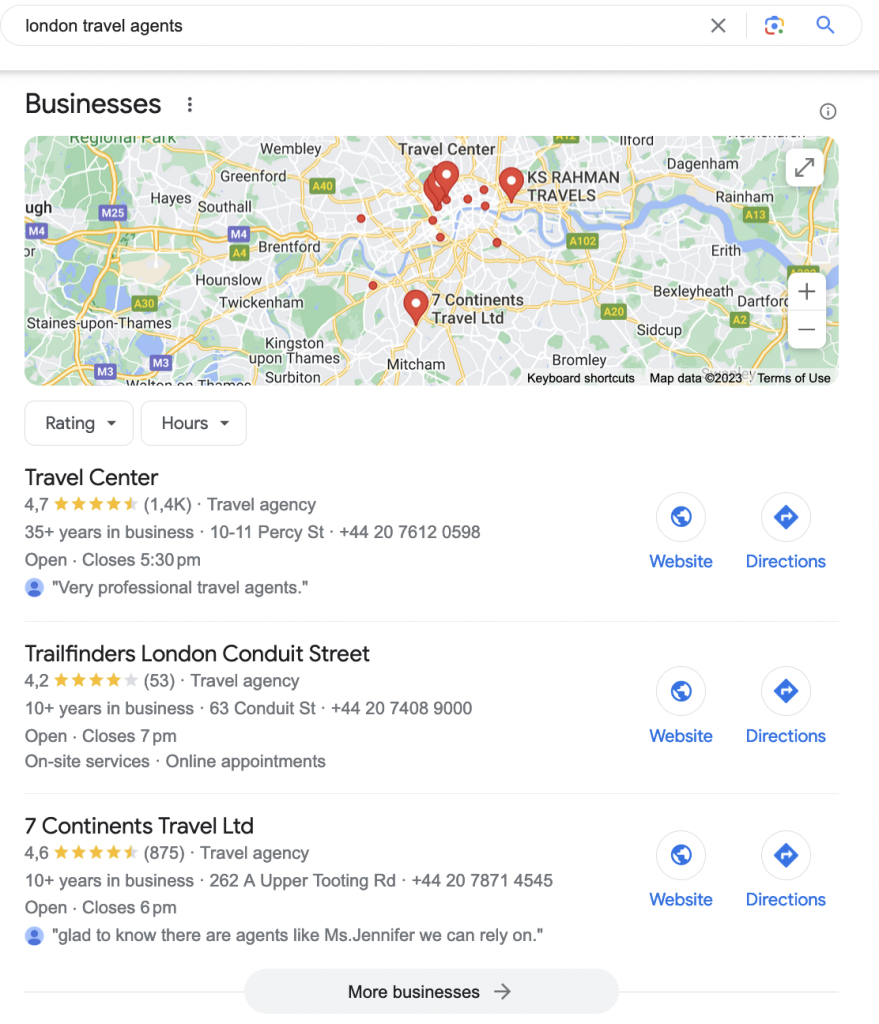
Travel agents and tour operators can thus capitalize on this opportunity offered by Google Maps to get their business listed for relevant local keywords.
If your business fits into this category, the tasks tasks you should focus on are:
- Local keyword research
- Optimizing the Google Business Profile for those keywords
- Gathering lots of positive reviews
- Building citations across trusted directories.
You should also have dedicated landing pages for your local keywords, such as a page targeting a keyword like ‘sailing tours croatia’, for example, which gives all of the information a visitor would need.
These landing pages can be supported by a blog that gives expert tips on your destination, backed up by solid keyword research and a clustering strategy, to drive even more traffic.
Travel agents will probably want to focus less on local SEO, since their offerings are usually spread across multiple destinations.
The exception is if there is good volume for a keyword like ‘travel agent in [your city]’, which may be the case for larger cities.
Travel agents can also make use of tourist trip schema and other types of structured data such as FAQ schema on tour pages to help crawlers understand the content of their tours and appear in more prominent positions in the search results.
Hotels and resorts
Hotel SEO and resort SEO requires a slightly different approach than tour operators and travel agents.
While local SEO and blog content can be important, hotels really have to consider their own branded search terms, with which they are in competition with OTAs over.
The reason for this is that hotels almost always have listings on several platforms, and as we’ve shown with the TripAdvisor example, many of these listings have a very strong search presence.
So hotels and resorts need to make sure that they are optimized for branded search terms around their property – that is, when somebody types in the name of the hotel into Google.
There are some very large hotels, hotel chains and large-scale luxury resorts that have several branded keywords, each with enough volume that you can actually find out which keywords to target.
Look at the Google autocomplete suggestions for the Hard Rock Hotel on the Riviera Maya, for example:
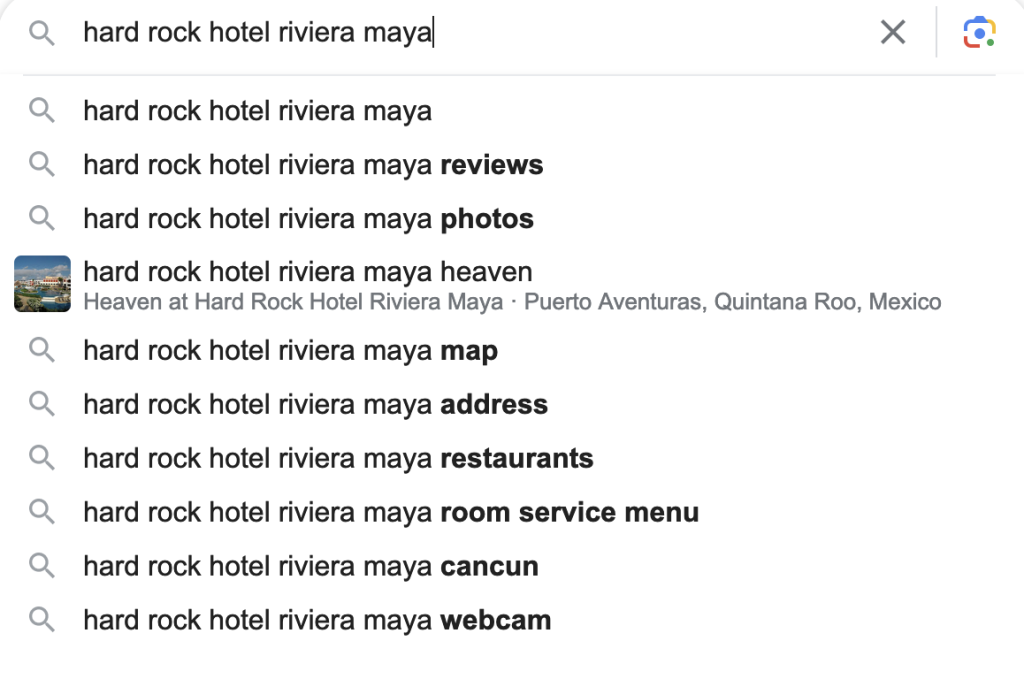
Just from the Google search bar we can see several branded keywords that this hotel should optimize for. Indeed, Hard Rock Hotel Riviera Maya have done a great job with their branded keyword targeting; rather than allow third-party websites to rank for these keywords, they have created individual pages targeting each of these branded keywords.
There’s a dedicated photo gallery, a contact page with a map and address, a page that explains the different restaurant options on site, a webcam link, and a PDF of the roof service menu.
Each of these pages targets the most popular Google queries around their hotel (as shown in the screenshot) and ranks first for its respective keyword, which helps to keep the official website visible, encourage more direct website bookings, and, crucially, decreases the risk of losing a booking to a third-party site.
Direct bookings are better for revenue, but they also allow you to collect valuable customer marketing data and upsell perks like loyalty programs, which in turn helps you refine your overall marketing strategy.
Smaller hotels might not have branded keywords in Google or keyword research tools, but that doesn’t mean that people don’t search for your hotel directly.
In fact, it’s easy to come up with a list of branded keywords that people might search when looking for information about your hotel. The process looks like this:
- Consider some of the main queries that your guests tend to have
- Ideate a list of possible branded keywords
- Craft pages that answer the question asked by the searcher and make it as easy as possible for them to find the information they are looking for.
Official hotel websites have an advantage over OTAs in the search results pages for their own branded search terms, but OTAs can be very powerful, and smaller hotels do occasionally get overtaken in the SERPs.
All of the strategies we’ve looked at in this article can apply to hotel SEO, but hoteliers would be wise to undergo a thorough audit of their current branded searches, asking questions like:
- How many clicks come through people searching for my hotel directly?
- How do people find my hotel once they are ready to book?
- Which pages should I create or optimize to bring in more direct bookings?
By asking these questions, you can gain a better understanding of where to allocate resources to drive up the volume of inbound enquiries and get more direct bookings.
Luxury travel brands
The main idea behind SEO for luxury travel is that you’ll be marketing to a specific, predefined target audience. For best results here, you need to make sure that your keyword research really aligns with that audience.
Read more: the complete guide to luxury travel SEO
As with tour operators, luxury travel landing pages should give as much information as possible, and make the value proposition clear immediately.
True luxury is about unique experiences that can’t be found anywhere else, and pages that can get that value proposition across straight away will keep searchers on the page much longer, (which could be a ranking factor in itself).
Link building between other luxury travel brands is also very important. Since luxury travel is a very specific niche, having relevant domains (rather than ‘generic’ travel sites) that point to your page with backlinks is a very strong signal of relevancy.
You could even go as far as to say that off-page SEO for luxury travel falls into the realm of PR, which has always been a big part of luxury travel marketing. Cultivating partnerships with newspapers, publications and social media influencers is a time-tested luxury marketing strategy, but it will also help you with your SEO by naturally increasing your backlink profile.
Finally, luxury travel brands are likely to have brand match keywords, so you need to rank for these keywords by optimizing for your brand name and any related information.
Conclusion: travel SEO can make your bookings skyrocket
We hope this in-depth guide has answered any questions you might have about travel SEO, its different forms, and how you can use it to work for your business.
If you’re serious about driving direct bookings through SEO, you can fill out our form to apply to work with Parador on a custom strategy for your business. We currently have capacity for three more clients in 2023, and successful applicants will hear back within one working day.

